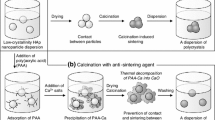Abstract
Nanocrystalline hydroxyapatite (HAP) particles were synthesized at room temperature using reverse microemulsions, in which cyclohexane was used as the organic phase, mixed surfactant with TX-100 and 1- pentanol, and CaCl2 solution as aqueous phase. The reactor systems with aqueous/organic volumetric ratios 1:10, 1:5, 2:5, and 1:2 were carefully selected for the microemulsion processing by the pseudo-ternary phase diagram and the electric conductivity measurement of the emulsion. The as-obtained HAP nanoparticles with carbonate substitution and broadening X-ray diffraction (XRD) traces were similar to the fine powder of human bone, despite of the aqueous/organic volumetric ratio in the emulsion. No obvious other’s phase occurred after as-obtained particles calcined under different temperature till 700 °C. In the emulsion-derived precursors, the HAP particles based on spherical morphology were prepared into the size between 15 ∼ 30 nm as a low volumetric ratio of 1:10 or 1:5 was applied. As the volumetric ratio increased to 2:5, the HAP particles with rod-like shape of (140∼280) × (10∼80) nm were formed. Practical implication of the results is that the nanocrystalline bone-like hydroxyapatite can be obtained via the emulsion processing at room temperature without further calcinations.







Similar content being viewed by others

References
Aoki H (1994) In: Medical application of hydroxyapatite. IShiyaku EuroAmerica Inc., Tokyo, St.Loui p 10
Hench LL (1991) J Am Ceram Soc 74:1487
Suchanek W, Yoshimura M (1998) J Mater Res 13:765
Takagi O, Kuramoto N, Ozawa M (2004) Ceram Int 30:139
Benmoussa A, Mikou M, Lacout JL, Siouffi AM (1995) J Chromatogr A 694:486
Jang KH, Song KB, Kim JS, Kim CH, Chung BH, Rhee SK (2000) Bioprocess Biosyst Eng 23:89
Lange FF (1989) J Am Ceram Soc 72:3
Ruys AJ, Wei M, Sorrelli CC, Dickson MR, Brandwood A, Milthorpe BK (1995) Biomaterials 16:409
Sonoda K, Furuzono T, Walsh D (2002) Solid State Ionics 151:32
Zhao F, Graysona WL, Ma T, Bunnellb B, Lu WW (2006) Biomaterials 27:1859
Sun JS, Wu YH, Lin FH (2005) Biomaterials 26:3953
Kim HW, Kim HE, Salih V (2005) Biomaterials 26:5221
Kokubo T, Kushitani H, Sakka S, Kitsugi T, Yamamuro T (1990) J Biomed Mater Res 24:721
Rao RR, Roopa HN, Kannan TS (1997) J Mater Sci Mater Med 8:511
Tas AC, Korkusuz F, Timicin M, Akkas N (1997) J Mater Sci Mater Med 8:91
Rhee SH, Tanaka J (1998) J Am Ceram Soc 81:3029
Wang F, Li MS, Lu YP, Qi YX (2005) Mater Lett 59:916
Ioku K, Kawachi G, Sasaki S (2006) J Mater Sci 41:1341. doi:10.1007/s10853-006-7338-5
Lim GK, Wang J, Ng SC, Gan LM (1996) Mater Lett 28:431
Koumoulidis GC, Katsoulds AP (2003) J Colloid Interface Sci 259:254
Bose S, Susanta KS (2003) Chem Mater 15:4464
Chen CW, Riman RE, Techuisen KS, Brown K (2004) J Cryst Growth 270:615
Guo GS, Sun YX, Wang ZH, Guo HY (2005) Ceram Int 31:869
Qi L, Ma JM, Cheng HM, Zhao ZG (1997) J Mater Lett 16:1779
Lam AC, Schechter RS (1987) J Colloid Interface Sci 120:42
Jillavenkatesa A, Condrate RA Sr (1998) J Mater Sci 33:4111. 10.1023/A:1004436732282doi:10.1023/A:1004436732282
Zhan YJ, Zheng CL, Liu YK, Wang GH (2003) Mater Lett 57:3265
Luo Q, Zhao XH, Zhou G (2004) Chem J Chinese U 25:1085
Lim GK, Wang J, Ng SC, Chew CH, Gan LM (1997) Biomaterials 18:1433
Lai C, Tang SQ, Wang YJ, Wei K (2005) Mater Lett 59:210
Layrolle P, Ito A, Tateishi T (1998) J Am Ceram Soc 81:1421
Kensaku S, Tsutomu F, Dominic W, Sato K, Tanaka J (2002) Solid State Ionics 151:321
Acknowledgements
This work was supported by the national key project program of China (No.1999054306) and program of ministry of science and technology in China (2001AA625050) to Pro. Changren Zhou.
Author information
Authors and Affiliations
Corresponding author
Rights and permissions
About this article
Cite this article
Li, H., Zhu, M., Li, L. et al. Processing of nanocrystalline hydroxyapatite particles via reverse microemulsions. J Mater Sci 43, 384–389 (2008). https://doi.org/10.1007/s10853-007-2182-9
Received:
Accepted:
Published:
Issue Date:
DOI: https://doi.org/10.1007/s10853-007-2182-9


